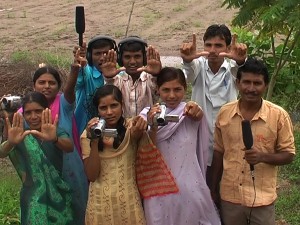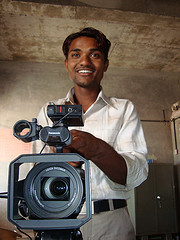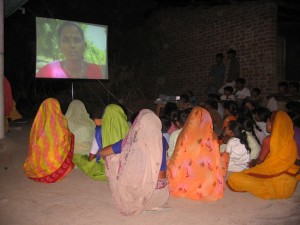Recently, our friend Aaditeshwar Seth of Gram Vaani Community Radio (and a fellow Knight News Challenge winner) spent a few days visiting Apna Malak Ma, the all-Dalit CVU in rural Surendranagar district of Gujarat set up by Navsarjan along with VV.
We thought his field notes captured well the local area (highly feudal, with considerable caste violence and caste politics to contend with) the CVU (active young leaders making inroads on caste issues) and the technology challenges and possibilities. As winners of the Knight Collaboration Prize at the MIT Future Civic Media Conference 2010, we’re going to be working with Aadi to create a voice sms system to enable direct reporting by the villagers.
What follows was written by Aadi in email, and lightly edited by VV
 July 23, 2010 -- I went down to Ahmedabad last week and spent some time with Mehul from Video Volunteers. Then we went to Limbdi and I stayed back with the CVU for two days. It was indeed a humbling experience to see all the great work that everybody was doing.
July 23, 2010 -- I went down to Ahmedabad last week and spent some time with Mehul from Video Volunteers. Then we went to Limbdi and I stayed back with the CVU for two days. It was indeed a humbling experience to see all the great work that everybody was doing.
Issues
The subjects that the CVU works on are mostly of grass root issues. These include
Below Poverty Line (BPL) card (a government document certifying a person as poor and therefore can claim to different government poverty elimination schemes.),
domestic violence, female infanticide, stigma faced by single women, RTI, ration cards, water problems, health problems, corruption, HIV/AIDS awareness, education, migration, sanitation, employment and land rights.
The Producers
I stayed with the CVU folks. They are quite poor, parents and brothers are labourers, mostly eat rotis with little vegetables and once they gave it to me only with salt/onion. But all of them have studied to 12th standard, are fluent with reading and writing Gujarati and some English/Hindi, and very intelligent and aware. Sad that such folks were just labourers earlier, lucky that they are now running the CVU, but what about so many other youth? Even if folks do get educated, there are just not enough jobs around. Entrepreneurship and manufacturing really need to pick up in India.
Most girls here complete class 12 and get into menial labour work, but Neeru, one of the women CVU producers, had been taking computer classes, language classes, and was very focused on self development. Navsarjan, the NGO that sponsors the CVU, presented the opportunity to join the CVU. Later Neeru married Jeetu, a fellow CVU producer! Neeru is still studying part time, and recently passed the 1st year from Saurashtra University.
Jeetu, Neeru’s husband and a CVU producer, is a very intelligent guy. Has worked as a labourer, in diamond polishing, in a factory, when he eventually met Video Volunteers’ founding director Stalin and was selected for the CVU work. Everybody really looks up to Stalin. Jeetu proudly says that he was selected by Stalin in the first round itself!
Girish Bhai, a distributor, can do other electrical work and earn more, but very committed to social work like the CVU coordinator Manji Bhai. Girish wants to go into politics after 10 years. Has a very good reputation in all the villages as a result of doing the screenings. Very hard working -- does NGO social service during the day, and screenings in the night.
Pushpa, another CVU woman worker also works on distribution with Girish, and is the first woman from the district to get a three wheeler driving license for going to screenings! Saurashtra has a lot of motorcycles retro-fitted into a three wheeler rickshaw for carrying people and goods, called a Charkha, and the CVU uses this for screenings.
Manji Bhai, the CVU team leader, is a very interesting personality -- extremely committed to social work and activism, and also an excellent singer. Writes and sings to motivate people to rise. Once a senior person had a heart attack and died when listening to Manji Bhai's call-to-action following a Dalit murder! On the go all the time, and on very good terms with all newspapers and all party representatives in the area. Does not take sides. But a strategist -- will report success stories in BJP led areas to the pro-BJP newspaper, same for Congress. Said that the amount of impact he has had in the last 3 years because of the CVU, is more than what he had in the last 15 years as an activist!
-Upper caste Thakur women are not allowed to step outside their homes, but at the CVU screening, finally one lady did come out to speak on the mic. Lots of crying and tears when they tell their stories.
- Lots of local caste-based politics. BJP and Congress are the main parties, and the Thakurs are the most powerful. Only about 15,000 thakurs out of 127,000 people, but all MLAs are Thakurs. Carefully split the Dalit vote and do not allow Dalit leaders to rise. The Thakurs will have two Dalits stand against each other from the same village, one for BJP and one for Congress. BJP and Congress are friends at this point, come together to split the vote, hardly matters who comes to power and the understanding is each party will get five years in charge, then the other party will get five years. Many Dalit youth are in jail on rape and murder charges, ~350 accused out of a maximum prison strength of ~250. Upper castes use the Dalits as pawns, but people unfortunately cannot see through all this
- Recently a Dalit was murdered, after standing up against some thakur youth who would drive their bikes recklessly through a street where Dalit kids played. Strong community spirit, but the local MLAs manipulate -- take the body and we will have the 14 accused arrested, get the camera people out, we will get you compensation (apparently, if a Dalit is murdered allegedly as a result of caste-based violence, the family is entitled to 250,000 rupees in compensation.)
- Politics also hurts the CVU people. If they talk about the lack of water facilities in some village, the local BJP representative says that they are speaking against them and call Manji Bhai. He has to handle the situation. But often some Sarpanch do go against the CVU and bar them entry into their village. Once Manji Bhai called the local government official and told them that the film was on water/health and part of a project by the government to spread awareness, but they were not being allowed to screen the film in this particular village. So the government guy called the same village leader and told him to support the CVU, and the Sarpanch turned into their volunteer!
- Some villages are great, some are weird though. There is one village with a lot of alcohol shops, and the youth/men are always drunk towards the night. The CVU have screened multiple times there, but nobody comes forth to champion some issue. Navsarjan's approach is to support local champions, but not champion the cause itself. They did that once though by cracking down a 1 million rupee “National Rural Employment Guarantee scheme mis-reporting in the village, but still the villagers are indifferent. They just don't care about protesting or working towards a solution for their problems.
- If a woman stands up to raise her voice, that is the best. Men are fickle. The CVU also puts together Women’s Committees in different villages, to demand for better water facilities
- The CVU once found a village that nobody knew about! About 1500 people, who hadn't seen a government official or MLA or an NGO worked in the last 5 years. CVU screened films in the area and then took up issues to have a road built to the village, cut away the surrounding babool trees, etc
- Another interesting success story, not for the CVU per se, but for Navsarjan. A Dalit once beat up his wife, and the local BJP authorities tried to captialize on this. Just to show their support for women and to show-off their strength, the local police officer beat up the husband, paraded him around naked, had him dance in a female costume, shoved a pole up him, beat him up badly, then bathed him and took him to court to confess. Navsarjan took up the police brutality and eventually had the police officer (a thakur) suspended.
Impact
- The CVU producers have gained considerable recognition in the community. People call them for just about anything -- rape cases and murder are extremes, but even for things like getting BPL certificates, school admissions, housing loans, RTI applications
The CVU’s Production Process
- Select an issue. "Take events, and turn them into issues"
- Forming two work groups: Production (~5 people) and Distribution (~2 people)
- Screenings in neighboring 42 villages, target is ~18 screenings per month
- Screenings followed by "call to action" and feedback session
- People encouraged to question what's happening in their own village/community
- Give suggestions for more topics, identify specific events
- Screening attended by 250 people!
Production process
Issue identification
Research: Find out what's happening in different areas in this regard -- whom to interview, what are the relevant government schemes, get information from specific NGOs in the area, parda faash/expose!
Put together a story line: Mehul and Manish from VV help
Shoot
Takes about 3-4 months per film. But had three films going in parallel, on corruption, on single women, and on HIV
Sometime films also subtitled in Hindi
Also take regular footage of any events, even if they put together a film later about the issue.
Some Films They have Made
Education: Is migration a problem? Migration card needed to get admission to a different school. In what villages do youth not go to school? Eventually, CVU helped to get children admitted.
Water: Standing water problems in different areas, flourine in ground water in some places. Who is the corporation head, what does he have to say? Later put together women’s groups to follow on
Sanitation: Toilet facilities in different areas? Later, helped get funds from the corporation to set up public toilets
Land: Most land owned by thakurs (Upper Castes). After the screenings, ending up filling over 800 forms on land claims
Feedback on the community screenings
- Finally got to see a screening the second night of their film on RTI.
- In a small village called Sudambada. About 100 people attended, mostly youth and old folks. More crowd probably did not show up because it had rained just a little while ago, and the roads were all wet. There were about 10 women, but sitting on the side. Shown on the main gathering point in the village. We had to continuously chase away cows that kept straying into the scene
- People listened attentively. Interaction was not heavy though. But 2 people did come forth to get RTI forms
Equipment 
- 2 computers, 2 video cameras, very low cost operations
- Projector for screenings in public spaces. Face a problem with power though, if no power then no screenings. Can probably make use of pico-projectors operated from a battery. Also face a problem with rains, no screenings if it rains. Also need help with recording feedback. Video is hard in the night.
- Screening will get a lot of help from a pico-projector that runs from a battery. Otherwise, problem with trying to find a power source.
- Girish, a CVU producer says, "40K projector lasts about 1000 hours". But maybe lesser, about 500 or so, because they have changed the projector once but have not had 1000 hours of screenings as yet.
What’s captured in their Annual report
- Activities: Screenings, court, Navsarjan programs (attendance, shooting), Mahila panch meetings, government office, training
- Report on attendance at screenings, how many men, women, children, etc
- Impact and feedback from screenings
- Problems in screenings: Drunken youth, resistance from Sarpanch, rains, equipment failure
- All reporting in Gujarati. Slow but maintain rigour of typing out reports in Gujarati on the computer
Future Technology Possibilities
Much of my effort was in trying to understand the context and test the validity of some of our ideas. Some things do seem to make sense. For example, the voice-messaging application could be useful for people to report incidents, or give comments in response to a "topic of the month" feature that the CVU puts out. SMSes could also be used for the same purpose. Much of this is already done through personal interactions and phone calls, so the system could help formalize it. But more than that, I think the system will be very useful for human-rights groups in general. Gram Vaani’s already done this with one NGO, but there is much use in packaging the solution and offering it to other groups. I will continue to work on this with my students and Gram Vaani.
DVD distribution – a possible model for the CVU?
Most movie DVDs get written in Ahmedabad or elsewhere, and distributed to the main towns nearby, from where local village shopkeepers get copies
Also very popular are wedding videos. Many people have cameras and shoot movies, but get them edited from a studio in Limbdi. About 3000/= per recording.
Person also records public functions such as NGO events or school events.
Navsarjan with VV’s help in setting it up runs a wedding video production course. Producers are very interested in photography, coming to Delhi for a photo-fair in January
In a Dalit home, I saw a Picassa photo slideshow of a road trip by some relatives, overlaid with Bollywood songs. Kids said that they were seeing it for the 10th time!
It may not be too difficult to set up a DVD distribution network, but see below for more questions
An interesting idea that did come up (from Jeetu) was to charge Re.1 for a lucky draw at all screenings, and distribute DVDs to the winners. This could help cover the screening costs. Could also show ads during the screenings for some minor advertising money
Open questions
Can social media be useful in itself, without some supporting human-rights group? There seem to be such strong power plays here! Media seems to help primarily to articulate issues and convey the possibilities of bringing change. People of course already know about the issues, so this is like a prod to get them going, but the real push needs the NGO to get involved. But one thing is for sure, that we need to look around for good human-rights groups, or those that are closely meshed with the community, for good use of our solutions.
Will the possibility of selling social media videos directly to the people really work? Discussed a lot with Jeetu, ideas like supplementing the serious documentary style films with local music videos, or local news, or even creating a few fictional characters and tracing their work through the social system with a film a month (provided somebody volunteers to write the script)... but couldn't get a very good feel for whether it will work or not.
The distribution channel may not be very hard, and people can even be encouraged to watch the DVDs and then share it with their friends, and advertising too may work out, but the fundamental question comes down to the content. There is already lots of content out there -- Bollywood style, local movies, soaps on cable TV, etc -- will people really appreciate social media and pay for it? I think it will require a lot of ground work with some local NGOs. Social networks do exist, and people will appreciate local content, but there are open questions on the content quality, the mix, and the relevance.
Commemorating soldiers of The Indian National Army in Betul
In this video, our community correspondent Mohanlal Sheelu is participating in a program commemorating the ex-soldiers of INA. From the Ghoradongri block of Betul District, Madhya Pradesh, around 200 people had joined the Indian National Army.
IMPACT | Village in Goa Gets Road After News of Elections Boycott Made Headlines
Villagers of this South Goa village finally have an all-weather road.

